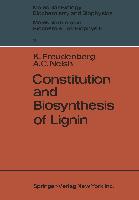- Start
- Constitution and Biosynthesis of Lignin
Constitution and Biosynthesis of Lignin
Angebote / Angebote:
Among terrestrial plants the vascular plants are the largest and the most con spicuous. Because of the presence of lignified supporting and conducting tissues such as xylem, terrestrial vascular plants can develop large upright forms. Composed mainly of xylem tissue, the stems of trees are characterized by elongated cells with thickened walls, impregnated by lignin. Diagrams of xylem cells (vessels, tracheids and fibers) can be seen in textbooks of plant anatomy (e. g. ESAU, 1953). A cross section of xylem tissue is shown in the section of this volume written by Professor FREUDENBERG (Fig. 1, p. 98). In general the occurrence of lignin in the plant kingdom is associated with the presence of these cells which comprise xylem. Thus lignin is found in vascular plants such as lycopods, ferns, gymnosperms and angiosperms, whereas it is absent from simple plants such as fungi, and from all other organisms. The mosses are an exceptional group which do not have the cells characteristic of xylem tissue but which contain lignin-like materials. These "moss lignins" have been discussed by Professor FREUDENBERG in this volume, and some doubts have been expressed as to whether or not they are true lignins (FR. * pp. 113-114). Work on the chemistry of lignin indicates that it is a polymer derived from the phenylpropanoid compound, coniferyl alcohol and related alcohols.
Folgt in ca. 5 Arbeitstagen
